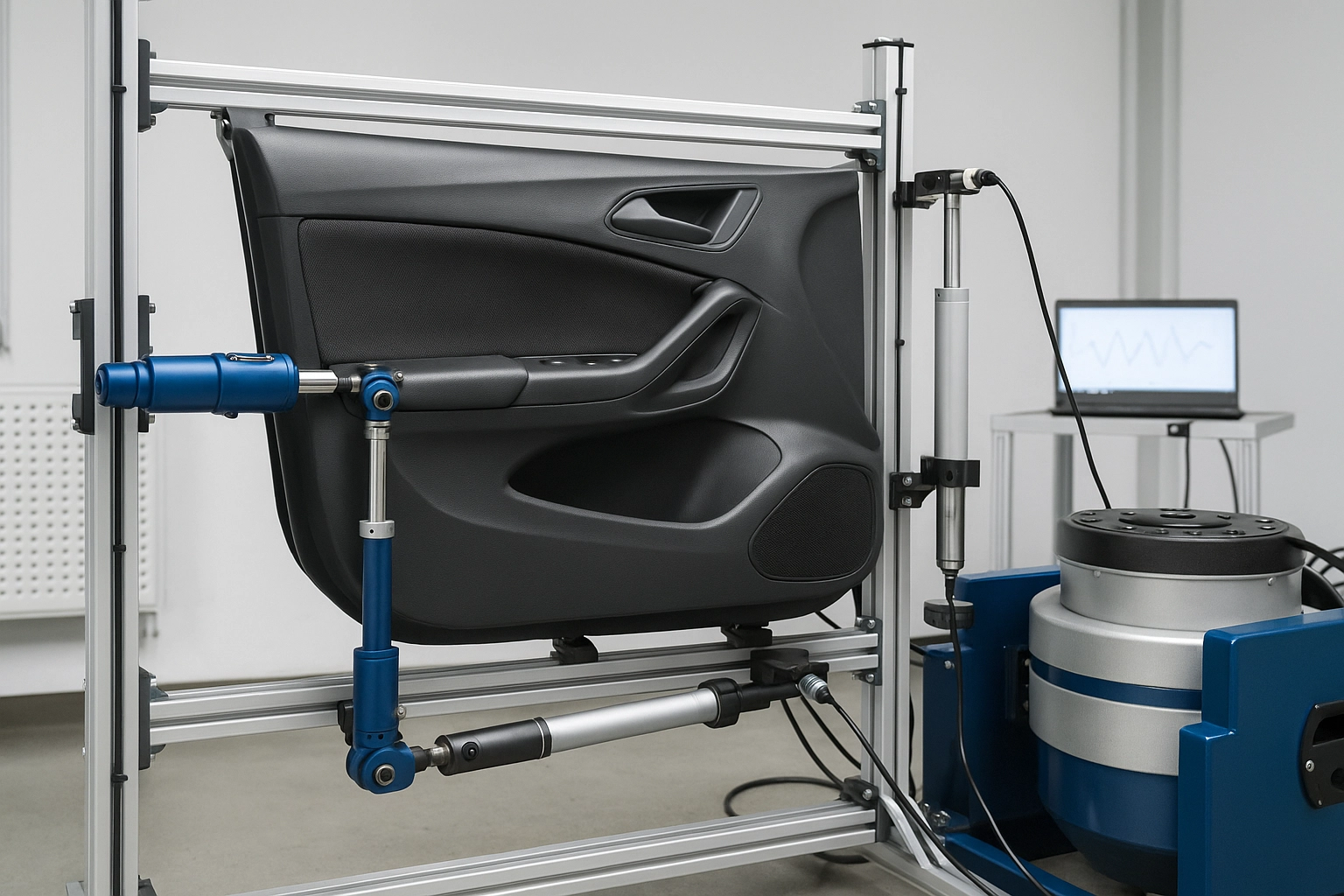SAE J1455 Vehicle Environmental BSR Durability Testing
The SAE J1455 Vehicle Environmental BSR (Buzz, Squeak & Rattle) Durability Testing is a critical standard that ensures vehicles maintain their performance and reliability under various environmental conditions. This testing method evaluates how well the vehicle components resist noise and vibration over time, ensuring customer satisfaction and regulatory compliance.
The SAE J1455 test protocol involves exposing the vehicle to simulated real-world environments such as temperature swings, humidity variations, and varying road conditions. The aim is to assess the durability of vehicle parts that contribute to BSR issues, including seats, door panels, trunk lids, and other moving components.
The testing process begins with a thorough understanding of the vehicle's design and its potential sources of noise and vibration. This includes identifying critical areas where BSR issues are most likely to occur and focusing on these during the test. Specimen preparation is crucial; it involves mounting the relevant components onto a test rig that can simulate actual in-vehicle conditions.
Instrumentation plays a vital role in this testing process, as precise measurements of noise and vibration are necessary for accurate results. Sensors are strategically placed to capture data on sound levels and vibrations across various frequencies. This allows for detailed analysis to identify any potential sources of BSR issues early in the development stage.
The test rig is designed to replicate real-world conditions by subjecting the vehicle components to a range of environmental stresses, including temperature changes from -40°C to +85°C and humidity levels up to 93% relative humidity. This ensures that any potential BSR issues are identified under extreme conditions that the vehicle might encounter during its operational lifecycle.
After completing each test cycle, the data collected is analyzed using advanced software tools to determine whether the components have held up against environmental stresses without developing unacceptable levels of noise or vibration. If issues arise, they can be addressed through design modifications before production begins.
The SAE J1455 testing process not only enhances vehicle quality but also contributes significantly to improving overall customer satisfaction by reducing complaints related to noise and vibration. By adhering to this standard, manufacturers ensure that their vehicles meet stringent industry benchmarks for durability and performance under challenging environmental conditions.
Real-world applications of SAE J1455 testing are numerous. For instance, automakers use it during the design phase to identify areas needing improvement early on, avoiding costly redesigns later in the development cycle. Additionally, this testing helps maintain consistent quality across different manufacturing plants worldwide by providing a standardized approach.
In summary, SAE J1455 BSR durability testing is essential for maintaining high standards of vehicle performance and reliability. It ensures that vehicles meet stringent industry benchmarks while contributing to enhanced customer satisfaction and reduced warranty claims.
Benefits
- Enhanced Quality Assurance: Identifies and rectifies potential BSR issues early in the development stage, ensuring consistent high-quality products.
- Improved Customer Satisfaction: By reducing noise and vibration complaints, automakers can enhance customer loyalty and satisfaction.
- Cost Savings: Early identification of design flaws through rigorous testing reduces the need for costly redesigns during later stages of production.
- Regulatory Compliance: Ensures that vehicles meet all relevant standards set by regulatory bodies worldwide.
- Innovation and Development: Provides valuable insights into areas where innovation can be applied to further enhance vehicle performance.
Environmental and Sustainability Contributions
The SAE J1455 Vehicle Environmental BSR Durability Testing plays a crucial role in promoting sustainability within the automotive industry. By ensuring that vehicles are robust enough to withstand varying environmental conditions, this testing contributes to longer product lifecycles. Longer-lasting products mean less waste generated from premature replacements, which helps reduce landfill contributions and promotes resource efficiency.
Moreover, by improving vehicle durability through rigorous BSR testing, manufacturers can optimize material usage without compromising on performance. This not only reduces the environmental impact associated with manufacturing but also supports sustainable practices throughout the entire lifecycle of a vehicle.
The SAE J1455 standard encourages the use of eco-friendly materials and processes during design and development stages. For example, manufacturers may choose biodegradable or recycled materials that align better with sustainability goals while maintaining structural integrity and functionality.
By adopting SAE J1455 testing protocols early in the production process, automakers can significantly reduce their carbon footprint by minimizing energy consumption required for rework or replacement of defective parts. This contributes positively to reducing greenhouse gas emissions across supply chains involved in automobile manufacturing.
In conclusion, implementing SAE J1455 BSR durability testing is an effective way for the automotive industry to contribute towards environmental sustainability without sacrificing product quality or customer satisfaction.
Competitive Advantage and Market Impact
The implementation of SAE J1455 Vehicle Environmental BSR Durability Testing provides several competitive advantages that can significantly impact market positioning. One key benefit is the ability to offer products that meet stringent industry standards, thereby enhancing brand reputation among consumers who value reliability and quality.
Another advantage lies in the early identification and resolution of design flaws through comprehensive testing procedures. This reduces the likelihood of post-production issues leading to negative publicity or recalls, which could damage customer trust and sales figures.
Additionally, adherence to SAE J1455 standards demonstrates a commitment to continuous improvement within the organization. Such initiatives resonate well with eco-conscious consumers seeking environmentally responsible choices for their vehicles.
Manufacturers who invest in advanced testing methodologies like those outlined by SAE J1455 are better positioned to capture market segments focused on sustainability and innovation. This strategic approach positions them favorably against competitors who may not prioritize similar standards or technologies.
In summary, embracing SAE J1455 BSR durability testing offers numerous benefits that extend beyond immediate product performance improvements. It fosters long-term relationships with customers by delivering consistently reliable vehicles while supporting broader sustainability goals within the automotive industry.





